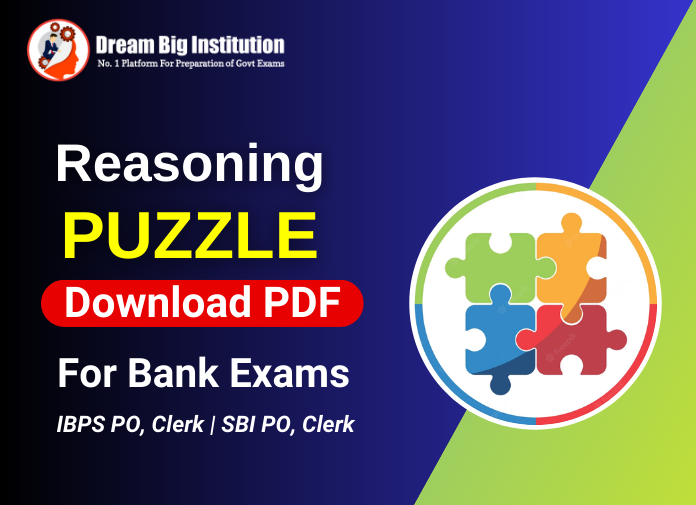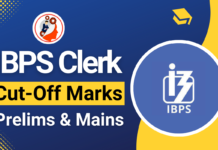Table of Contents
IBPS Clerk Puzzle PDF With Solution
Dear Aspirants,
Reasoning Puzzle For IBPS Clerk – You know in Reasoning is one of the most important sections is Puzzle which is usually asked in the set of 2-3, and can fetch you 15-20. Overall it covers around 50-60 % portion of the Reasoning Section in Prelims & Mains Exams. If you prepare the Puzzle topic well, you can boost your score in the Reasoning Section, and consequently the overall score.
Download Reasoning Puzzle For the IBPS Clerk Exam
Type of Puzzle Questions Asked in the IBPS Clerk Exam
1) Circular Arrangement Puzzle
2) Linear Arrangement Puzzle
3) Floor Arrangement Puzzle
4) Box Puzzle
5) Distribution Based Puzzle
6) Year Based Puzzle
The trick to solve Puzzle Questions
So let us try not to take tension and learn how to solve puzzles in an easy manner.

Easy way to solve the Puzzles:
Puzzles place a significant job in the Reasoning Section, that you can’t escape from this idea. The point deals with the Reasoning Section of a wide range of banking exams. Furthermore, numerous different incidental subjects also are being asked as puzzles know a day. The absolute number of questions being asked on puzzles ranges from 60 to 65% in the reasoning section.
Generally, most puzzles depend on floors, even form, blood Relation, and seating arrangement, and so on. In the test they can be asked in 5 to 10 factors, depending on the difficulty level questions. Likewise, Remember the Mix of seating arrangement and blood relations is additionally being as often as possible asked in the bank exams
1. Know your enemy – or in this case, the common puzzle structure.
2. Every battle has a plan – so should you!
3. Read once, start drawing –
4. Do not waste time
5. Keep reading and arranging –
6. Use tables
7. Indirect clues
Previous Year Asked Puzzle Questions
Directions (1–5): Study the following information carefully and answer the questions given below it.
Eight persons were born on 20th September but in different years among 1964, 1967, 1970, 1975, 1978, 1982, 1994, and 1999. They belonged to different countries among India, China, Japan, and the US such that two people were born in each country.
V was born in 1978. One who belongs to Japan is three years younger than T. V does not belong to Japan. Only three persons born between one who belongs to Japan who is three years younger than T and R. R belong to China. The number of persons born before the person who belongs to China and the number of persons born after the other persons who belong to China is the same.
T does not belong to China. W belongs to the US and W born immediately before S. There is five years difference between U and P. U is elder than P. P does not belong to Japan and India. S belongs to India. Q is one of the persons in the group.
1) W was born in?
a) 1994
b) 1999
c) 1964
d) 1967
e) None of these
2) S belongs to which country?
a) Japan
b) US
c) India
d) Cannot be determined
e) None of these
3) Who among the following does not belongs to the group?
a) T
b) U
c) Q
d) W
e) R
4) Who was born between P and R?
a) T
b) Q
c) W
d) V
e) S
5) How many persons born between Q and W?
a) One
b) Five
c) Three
d) Four
e) None
Ans – So the final arrangement is,

1) Answer: A
2) Answer: C
3) Answer: C
4) Answer: D
5) Answer: D
Check Category Wise Details
| IBPS Clerk notification | IBPS Clerk Syllabus | IBPS Calendar |
| IBPS Clerk Admit Card | IBPS Clerk Cut-offs | IBPS Clerk Study Material |
| IBPS Clerk Previous Year Papers | IBPS Clerk Salary | IBPS Clerk Result |
FAQ on Reasoning Puzzle for IBPS Clerk Exam
Q. What are the reasoning scoring topics for IBPS Clerk?
Ans: Top Scoring Topics for IBPS Clerk Prelims – Reasoning Ability, Because Puzzle is the most Important Topic Overall it covers around 50-60 % portion of the Reasoning Section.
Q. How to solve puzzles quickly in bank exams?
Ans: How Can I Solve Puzzle Fast in Bank Exam? The best way to solve puzzles with 100 percent accuracy is to each possible combination and keep canceling them out as candidates proceed. They should not ignore the important key points while reading the question. Two to three minutes are sufficient to solve easy puzzles.













